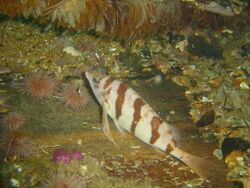Biology:Barred fingerfin
| Barred fingerfin | |
|---|---|

| |
| Scientific classification | |
| Domain: | Eukaryota |
| Kingdom: | Animalia |
| Phylum: | Chordata |
| Class: | Actinopterygii |
| Order: | Perciformes |
| Family: | [[Biology:|Cheilodactylidae]] |
| Genus: | Cheilodactylus |
| Species: | C. pixi
|
| Binomial name | |
| Cheilodactylus pixi M. M. Smith, 1980
| |
The barred fingerfin (Cheilodactylus pixi) is a species of marine ray-finned fish, belonging to the family Cheilodactylidae, commonly referred to as morwongs. It is found only in the southeastern Atlantic and southwestern Indian Oceans off the coasts of South Africa.
Taxonomy
The barred fingerfin was first formally described in 1980 by the South African ichthyologist Margaret Mary Smith with the type locality given as off the mouth of the Kowie River in the Eastern Cape in South Africa.[1] Phylogenetic analyses and genetic studies of the morwongs have not supported the traditional arrangement of the families Cheilodactylidae and Latridae. This has led to some authorities suggesting that the majority of species in Cheilodactylidae should be placed in Latridae.[2][3] A result of this rearrangement is that the only species which would remain in Cheilodactylidae are this species and C. fasciatus, both from southern Africa.[2] This is because these analyses resolved the genus Cheilodactylus as polyphyletic.[2][4] These studies appear to show that most of the species in Cheilodactylus sensu lato instead apparently to belong in several different genera and are not even members of the same family, but how many and their exact delimitation is not clear at present.[2][5][6] The outlier species have been assigned to Chirodactylus, Goniistius, Morwong and Pseudogoniistius, but DNA and morphologic analyses found those species to be nested within Latridae and more derived than the kelpfish, marblefish and this species.[6][4][2] The specific name honours Pixie John who lived in Port Alfred and sent the type specimen to Smith.[7]
Description
The barred fingerfin has a weakly pointed snout and a concave ventral profile.[8] The dorsal fin contains 18-20 spines and 19-23 soft rays while the anal fin has 3 spines and 8-11 soft rays. This species attains a maximum total length of 18 cm (7.1 in).[9] The overall colour of the ody is pale grey with a speckling of pale brown spots and overlain with four clear, diagonal brown bars. There is a fifth more indistinct bar to the back of the head extending to the base of the pectoral fins. The colour of the fins is translucent orange.[8]
Distribution and habitat
The barred fingerfin is endemic to South Africa where it is found from the False Bay to Coffee Bay in KwaZulu Natal.[10] This species can be found along rocky coastlines and on offshore rocky reefs at depths of 5 to 30 m (16 to 98 ft).[11]
Biology
The barred fingerfin feeds on benthic invertebrates. It is a solitary species which is often observed perched on the reef in the daylight hours.[11] It is known to be preyed upon by the copper shark (Carcharhinus brachyurus) and the sharptooth houndshark (Triakis megalopterus).[9]
References
- ↑ Eschmeyer, William N.; Fricke, Ron; van der Laan, Richard, eds. "Species in the genus Cheilodactylus". California Academy of Sciences. http://researcharchive.calacademy.org/research/ichthyology/catalog/fishcatget.asp?tbl=species&genus=Cheilodactylus.
- ↑ Jump up to: 2.0 2.1 2.2 2.3 2.4 Christopher P. Burridge; Adam J. Smolenski (2004). "Molecular phylogeny of the Cheilodactylidae and Latridae (Perciformes: Cirrhitoidea) with notes on taxonomy and biogeography". Molecular Phylogenetics and Evolution 30: 118–127. doi:10.1016/S1055-7903(03)00157-X.
- ↑ John E. Randall (2007). Reef and Shore Fishes of the Hawaiian Islands. ISBN 1-929054-03-3.
- ↑ Jump up to: 4.0 4.1 C. P. Burridge; R.W.G. White (2000). "Molecular phylogeny of the antitropical subgenus Goniistius (Perciformes: Cheilodactylidae: Cheilodactylus): evidence for multiple transequatorial divergences and non-monophyly". Biological Journal of the Linnean Society 70: 435–458. doi:10.1006/bijl.1999.0413.
- ↑ Eschmeyer, William N.; Fricke, Ron; van der Laan, Richard, eds. "Species in the genus Cheilodactylus". California Academy of Sciences. http://researcharchive.calacademy.org/research/ichthyology/catalog/fishcatget.asp?tbl=species&genus=Cheilodactylus.
- ↑ Jump up to: 6.0 6.1 Ludt, W.B.; Burridge, C.P.; Chakrabarty, P. (2019). "A taxonomic revision of Cheilodactylidae and Latridae (Centrarchiformes: Cirrhitoidei) using morphological and genomic characters". Zootaxa 585 (1). doi:10.11646/zootaxa.4585.1.7.
- ↑ Christopher Scharpf; Kenneth J. Lazara, eds (25 February 2021). "Order Centrarchiformes: Families Centrarchidae, Elassomatidae, Eoplosidae, Sinipercidae, Aplodactylidae, Cheilodactylidae, Chironemidae, Cirrhitidae, Latridae, Percichthydiae, Dichistitidae, Girellidae, Kuhliidae, Kyphosidae, Oplegnathidae, Terapontidae, Microcanthidae, and Scorpididae". The ETYFish Project Fish Name Etymology Database. Christopher Scharpf and Kenneth J. Lazara. https://etyfish.org/centrarchiformes/.
- ↑ Jump up to: 8.0 8.1 "Cheilodactylus pixi". Reef Life Survey. https://www.reeflifesurvey.com/species/cheilodactylus-pixi/.
- ↑ Jump up to: 9.0 9.1 Froese, Rainer and Pauly, Daniel, eds. (2021). "Cheilodactylus pixi" in FishBase. June 2021 version.
- ↑ "East Coast Fish-Watch Project Report August, 2005". South African Institute for Aquatic Biodiversity. https://fishwatch.tripod.com/REPORTS/reportaug2005.htm.
- ↑ Jump up to: 11.0 11.1 Dennis King (2014). The Reef Guide: fishes, corals, nudibranchs & other vertebrates East & South Coasts of Southern Africa. Penguin Random House South Africa.
- Froese, Rainer and Pauly, Daniel, eds. (2006). "Cheilodactylus pixi" in FishBase. April 2006 version.
- G M Branch, C L Griffiths, M L Branch, & L E Beckley, Two Oceans, A Guide to the Marine Life of Southern Africa, (David Philip Publishers (Pty) Ltd, Claremont, South Africa 1994) ISBN:0-86486-250-4
- Smith, Margaret M. 1980. Ichthyological Bulletin; No. 42: A review of the South African Cheilodactylid fishes (Pisces: Perciformes), with descriptions of two new species, J.L.B. Smith Institute of Ichthyology, Rhodes University 1980 ISSN 0073-4381
Wikidata ☰ Q2739458 entry
 |


